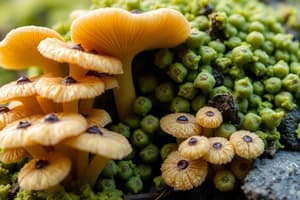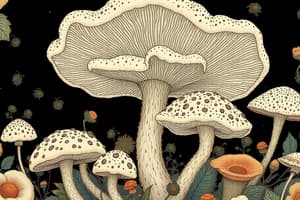Podcast
Questions and Answers
What is the primary role of fungi in ecological cycles?
What is the primary role of fungi in ecological cycles?
- Extracting nutrients from the soil
- Attracting pollinators for plant reproduction
- Breaking down dead organic matter (correct)
- Producing oxygen through photosynthesis
Which environment is likely to have a higher population of fungi due to crop residues and irrigation practices?
Which environment is likely to have a higher population of fungi due to crop residues and irrigation practices?
- Freshwater systems
- Deserts
- Agricultural soils (correct)
- Forests
What is the term 'mycobiome' referring to?
What is the term 'mycobiome' referring to?
- Communities of viruses
- Communities of plants
- Communities of bacteria
- Communities of fungi (correct)
Which of the following nutrients are released back into the environment during the decomposition process by fungi?
Which of the following nutrients are released back into the environment during the decomposition process by fungi?
In addition to forests and agricultural soils, where else can significant mycobiome habitats be found?
In addition to forests and agricultural soils, where else can significant mycobiome habitats be found?
What distinguishes fungi from bacteria and plants in terms of niche diversity?
What distinguishes fungi from bacteria and plants in terms of niche diversity?
What is the role of mycotoxins produced by certain fungi?
What is the role of mycotoxins produced by certain fungi?
How do human activities like deforestation and pollution impact fungal communities?
How do human activities like deforestation and pollution impact fungal communities?
What is a potential consequence of altered fungal compositions due to human activities?
What is a potential consequence of altered fungal compositions due to human activities?
Which evolutionary clade includes fungi and animals as possible members?
Which evolutionary clade includes fungi and animals as possible members?
What is the primary reason for studying fungi ecology according to the text?
What is the primary reason for studying fungi ecology according to the text?
How do mutualistic associations between fungi and bacteria influence ecosystems?
How do mutualistic associations between fungi and bacteria influence ecosystems?
Flashcards are hidden until you start studying
Study Notes
Fungi Ecology
Fungi are organisms known for their remarkable ability to decompose organic matter, break down waste, and recycle nutrients back into the environment. Their unique role in ecosystems gives them more niche diversity compared to other kingdoms like bacteria and plants. Here's an overview of how these fascinating microorganisms function within various environments.
Types of Mycobiome Environments
The term 'mycobiome' refers to all the fungal species living together in one community. These communities can vary significantly depending on factors such as soil type, geographic location, and human intervention. For instance, agricultural soils often have higher fungi populations due to crop residues and irrigation practices. Other notable mycobiome habitats include forests, grasslands, deserts, freshwater systems, marine ecosystems, and even extreme environments like Antarctica.
Key Components of Fungal Communities
Decomposition and Nutrient Cycling
One of the primary roles of fungi in ecological cycles is decomposition. They feed off dead plant material and animal carcasses by breaking down complex compounds like cellulose, lignin, chitin, proteins, and lipids into simpler forms. This process releases essential elements like carbon, nitrogen, phosphorus, potassium, sulfur, calcium, magnesium, iron, copper, zinc, manganese, boron, molybdenum, and selenium back into the environment. Additionally, some species thrive in symbiotic relationships with plants, helping them absorb water and nutrients from the soil.
Interactions between Different Species
In any given habitat, multiple fungal species coexist and interact with each other. Some of these interactions include competition, mutualism, commensalism, amensalism, parasitism, and predation. These interspecies dynamics play crucial roles in maintaining overall ecosystem balance.
For example, certain fungi produce antimicrobial compounds called mycotoxins which inhibit pathogenic microbes like bacteria and viruses. However, this also means they can negatively impact beneficial bacteria necessary for healthy soil functions. On the other hand, mutualistic associations between fungi and bacteria can enhance nutrient availability and promote diverse microbial communities.
Impacts of Human Activity on Fungal Communities
Human activities like deforestation, agriculture, urbanization, pollution, and climate change can alter fungal communities significantly. While some changes may lead to increased fungal abundance and diversity, others could result in reduced numbers or altered compositions. Understanding these impacts helps us predict possible consequences on natural ecosystems and maintain sustainable practices.
Phylogeny and Evolutionary History
Despite being relatively simple lifeforms, fungi exhibit complex evolutionary histories dating back over a billion years ago. They share common ancestry with animals and have undergone significant morphological, physiological, and biochemical transformations during their evolution. Recent molecular studies suggest that there might be two separate origins for fungi—the Opisthokonta clade (which includes animals) and the Amoebozoa clade (whose members are predominantly unicellular).
Conclusion
Understanding fungi ecology is critical, especially amidst growing concerns regarding global environmental health. By studying these organisms and their interactions within different ecosystems, we can better understand how they contribute to overall ecosystem stability and resilience against disturbances caused by humans. Moreover, appreciating their presence in our daily lives heightens awareness of their importance for our wellbeing, from food production to health maintenance via probiotics and medicines derived from fungi.
Studying That Suits You
Use AI to generate personalized quizzes and flashcards to suit your learning preferences.




